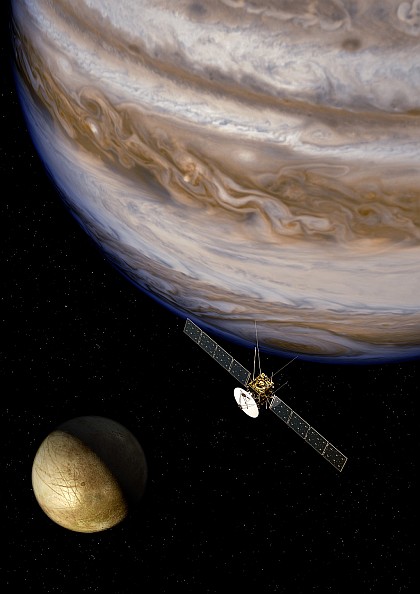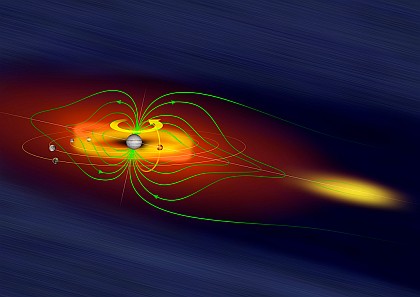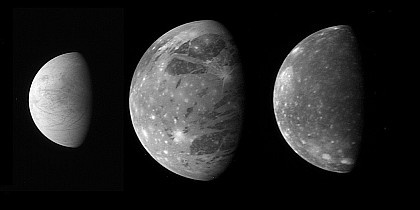Press Release 4/2013 - February 22, 2013
Icy Exploration of the Jovian System
The Max Planck Institute for Solar System Research contributes to two instruments for ESA's mission JUICE.
ESA's space probe JUICE (JUpiter ICy moon Explorer) is scheduled to embark on its epic voyage to Jupiter and its icy moons in 2022. One of the mission's main goals is to clarify whether liquid water (and thus the precondition for the evolution of life) can be found hidden deep within Jupiter's moons Ganymede, Callisto, and Europa. ESA has now chosen the scientific instruments to participate in the mission. The Max Planck Institute for Solar System Research (MPS) in Germany will contribute to two of them. The Submillimeter Wave Instrument (SWI) designed to scan the Jovian system for chemical compounds such as water, methane, and carbon monoxide will be developed and built under the lead of the MPS. In addition, the institute will contribute an electron spectrometer to the Particle Environment Package (PEP).
The Jovian system located almost 780 million kilometers away from the Sun is an icy, dark world. Only four percent of the sunlight that reaches Earth arrives there; the average temperature lies below minus 140 degrees Celsius. "The Jovian system offers many superlatives: Jupiter is not only the largest planet in our solar system. It also has the strongest magnetic field", Dr. Norbert Krupp from the MPS, member of the international team of scientists who defined the goals and tasks of JUICE last year, describes the mission's destination. In 2030, JUICE will arrive in the Jovian system to study not only the gas giant itself, but also Ganymede, Callisto, and Europa, three of Jupiter's 67 moons. Unlike the huge planet, these moons are solid bodies that may be structured in layers similar to the inner planets Mercury, Venus, Earth, and Mars.

|
Figure 1: Apart from the gas giant Jupiter itself, ESA's space probe JUICE will focus on the moons Ganymede, Callisto, and Europa.
|
(Credits: ESA/AOES)
|
"Data from older missions and computer simulations indicate subsurface oceans stretching beneath their outer layers of ice", says Krupp. One of JUICE's aims is to find out, whether these three bodies are as active as for example Saturn's moon Enceladus. In this case, material from the interiors could reach the surface and the atmospheres through cracks and grooves. These "messengers from within" could deliver important information to the scientific instruments onboard the spacecraft.
The Submillimeter Wave Instrument (SWI) will be one of these instruments. Within the next years it will be developed and built under the lead of the MPS. SWI will analyze the extreme infrared radiation emitted into space by rocks, ice, and atmospheres of the moons as well as by the atmosphere of Jupiter at the wavelengths of 0.5 and 0.25 millimeters. "Many chemical compounds such as water, oxygen, carbon monoxide, and methane and other hydrocarbons leave their fingerprints in this part of the infrared spectrum", says Dr. Paul Hartogh, SWI's Principle Investigator.
"With our measuring method it will be possible for the first time to determine the three-dimensional distribution of important trace substances in Jupiter's atmosphere with a high spatial resolution and within a previously non-accessible region of the planet's stratosphere", he adds. In addition, the measurements will make it possible to study temperature and wind speed profiles within the atmosphere. Such meteorological data may, for example, help understand, how the great hurricane-like storm on Jupiter, that is visible from Earth with amateur telescopes, came to be - and why it has hardly changed for several hundreds of years. It is also not yet known, what substance is responsible for its prominent red coloring.

|
Figure 2: The spacecraft JUICE will study the complex interplay of Jupiter's magnetosphere (green lines), its moons, and a ring of uncharged particles around the planet (yellow ring).
|
(Credits: MPS)
|
SWI will take an especially good look at the water found within the Jovian system. The goal is to determine the exact ratio of so-called heavy water to normal water. In heavy water, one hydrogen atom is substituted by a heavy isotope of hydrogen. Since according to our current state of knowledge this ratio is believed to increase with increasing distance from the Sun, researchers hope that these measurements will help them understand where Jupiter's water originated. In addition, SWI will for the first time identify rare isotopes such as the heavy isotopes of oxygen 17O and 18O, the nitrogen isotope 15N, and the carbon isotope 13C in the atmospheres of Jupiter and the moons.
However, since many of these infrared signals are limited to a very narrow range of wavelengths, they are extremely difficult to detect. The demands on the spectral resolution of SWI are therefore significant. In solving this problem, Hartogh and his team have chosen to use the heterodyne-principle for SWI. By superposition with a reference wave, the frequency of the incoming signal is shifted into the region of classical radio waves. These waves are then processed. In this manner, even the most narrow spectral signals can be detected.
Mass, speed, direction, and charge of the particles in the atmospheres, exospheres, and magnetospheres of Jupiter and its moons will be studied by the Particle Environment Package (PEP). PEP is not a single instrument, but rather a package of six different mass spectrometers for charged and uncharged particles. Each one is designed to study particles within a certain mass and energy range.

|
Figure 3: The destinations of the JUICE mission: Europa, Ganymede, and Callisto (from left to right). These images where taken during the flyby of NASA's space probe New Horizons six years ago.
|
(Credits: NASA)
|
In an indirect manner this instrument may deliver the crucial proof for a subsurface ocean on Ganymede - and thus contribute significantly to the mission's success. "If there is liquid water beneath the surface of Ganymede, it has to give itself away by means of its magnetic field", says Krupp, one of PEP's Co-Investigators. The varying magnetic surroundings of Ganymede would induce electrical currents in the ocean which in turn would be the source of magnetic fields. "Filtering out these contributions to the magnetic field as a whole is very difficult", explains Krupp. In order to do this JUICE-scientists will have to determine the source of all of the field's components. In this endeavor, PEP will be able to clarify the influence of the charged particles in the atmosphere. The MPS will contribute an electron spectrometer to PEP.
In addition, researchers from the MPS will take part in analyzing data from the Moons and Jupiter Spectrometer (MAJIS), the Jupiter Magnetometer (J-Mag), the Ganymede Laser Altimeter (GaLA), and the camera system JANUS.
In May 2012, ESA chose JUICE as its next large scientific mission. The space probe is scheduled to be launched in 2022 and will arrive at it destination eight years later. After several flybys of Callisto and Europa, JUICE will enter into orbit around Ganymede. The spacecraft will carry eleven scientific instruments.
Additional Information
 ESA Press Release
ESA Press Release
Contakt
Dr. Birgit Krummheuer
Press and Public Relations
Max Planck Institute for Solar System Research
Max-Planck-Straße 2
37191 Katlenburg-Lindau
Tel.: 05556 979 462
Fax: 05556 979 240
Mobil: 0173 3958625
Email: krummheuer mps.mpg.de
mps.mpg.de
Dr. Norbert Krupp
Max Planck Institute for Solar System Research
Max-Planck-Straße 2
37191 Katlenburg-Lindau
Tel.: 05556 979 154
Fax: 05556 979 240
Email: krupp mps.mpg.de
mps.mpg.de
Dr. Paul Hartogh
Max Planck Institute for Solar System Research
Max-Planck-Straße 2
37191 Katlenburg-Lindau
Tel.: 05556 979 342
Fax: 05556 979 240
Email: hartogh mps.mpg.de
mps.mpg.de
